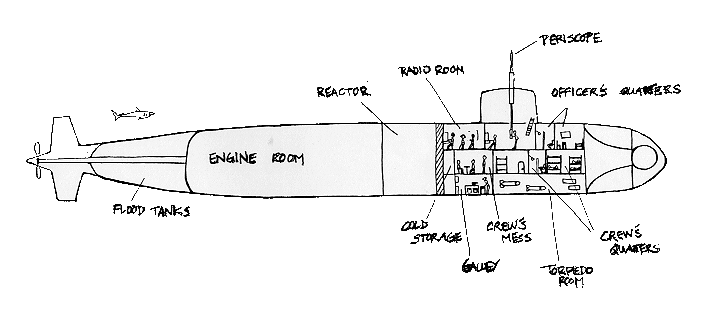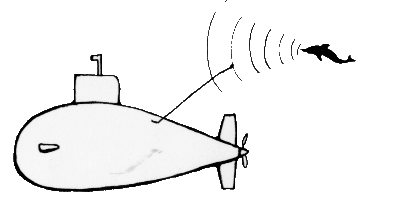Elements of Submarine Operation
DETECTION
A submarine's effectiveness depends on its ability to remain submerged and undetected. From this position beneath the surface, a sub can search, track, and attack using the element of surprise. The element of surprise has always been the submarine's greatest asset and is still considered its most powerful weapon. When surfaced, however, submarines are quite vulnerable, since modern subs operate more slowly and have less armament than surface ships. By surfacing, submarines surrender their invisibility.
The earliest submersible vessels operated blindly under the sea. Until the twentieth century the only way for a sub to see was by surfacing, thus revealing herself to surrounding vessels. Since 1903, naval submarines have used periscopes at shallow depths (about 60 feet) to get a view of the surrounding sea.
The development of RADAR (Radio, Detection And Ranging) during World War II allowed surface ships to talk with submarines and warn them of impending danger. Radio communication was established with a retractable antenna from the sub that rose above the surface. In order for this to work, the submarine had to come close to the surface. Another danger was that the radio transmissions could be detected and tracked, threatening to reveal the sub's location. It wasn't until the introduction of SONAR (Sound Navigation And Ranging) that submarines were able to capitalize on their stealth.
STEALTH
In order to go undetected, submarines needed something that concealed them from other boats or ships. SONAR offered submarines stealth. SONAR is a system that uses sound waves traveling through water to search for objects or geographic obstacles. There are two types of SONAR, passive and active.
PASSIVE SONAR picks up sounds using electronic listening equipment.
A target can be detected by the noise it makes from its machinery, the propeller, or the sound of the water passing around the vessel as it travels.
ACTIVE SONAR produces and emits a burst of sound or a 'ping'.
This is reflected back when it hits an object and is registered as a 'blip' on a screen. Active SONAR sends and receives sound transmissions. There is a danger that enemy SONAR will detect the ping.
SONAR is very important to submarines because it lets them see what is around them, without coming close to the surface. Submariners must listen carefully, because SONAR can pick up other sounds made by their own sub or sea creatures. When a sub is listening for a target, it also must be very quiet. Submariners even wear tennis shoes when underway to silence their footsteps!
To increase stealth, submariners take advantage of how sound waves act in ocean water. The speed of sound in seawater is greatly determined by temperature, pressure, and salinity. These three factors vary in different locations and bend the sound waves accordingly. Because SONAR depends on receiving sounds signals, the way sound waves bend determines what can be picked up by SONAR. Submariners can find places between the bending sound waves of active enemy SONAR called shadow zones. There, subs can hide and watch the enemy without being detected.
MANEUVERABILITY
Modern control systems enable a submarine to operate much like an airplane, but subs fly in a sea of water. Similar to a plane's wings and tail, a sub's hull-mounted hydroplanes allow the boat to ascend or descend several hundred feet per minute. Like planes, submarines must consider the topography of their surroundings. Underwater mountains and valleys, just like the continental ones, limit the maneuverability of submarines. SONAR is used actively to detect underwater obstacles and increase mobility.
HABITABILITY
Living conditions on a submarine are unique because the crew works, eats, and sleeps in a confined space that is beneath the sea. Through the 1920s, submarine crews were packed into tight spaces with equipment, machinery, weapons, and provisions. Berthing spaces (sleeping areas), heads (bathrooms), and community areas were intertwined within the subs' limited space, making life aboard exceedingly unpleasant and unhealthy. Food and body odors, combined with gasoline vapors and carbon dioxide, contaminated the limited amount of breathable air in the submarine.
Since World War II, the Navy significantly improved the environment onboard their submarines. Improvements in the air quality of subs was perhaps the most important change. The Navy learned from the mining industry how to filter out deadly carbon dioxide while the boat was submerged. Carbon Dioxide accumulated at a rate of one cubic foot per crew member per hour. With better ventilation systems, the air quality greatly improved.
Maintaining a constant source of drinkable water also was a problem. Modern submarines now carry distillation plants to make fresh water from salty seawater. Living conditions continued to improve when the Navy separated the eating, sleeping, and sanitary accommodations, and added lockers and storage facilities to cope with the lack of space on the submarine. Today, the habitability of a submarine is assured by equipment that makes fresh air and water, filtration systems that eliminate toxic vapors, and new designs that improve space management.

SPEED
While design helps improve the habitability of a submarine, it also improves its speed. Combined with stealth, speed is one of the modern submarine's greatest assets. Early submersibles were meant to cruise on the surface and submerge only for short periods. Because of anti-submarine warfare, modern subs need speed under water to escape attack. Although the actual top speed of American naval vessels is a secret, modern submarines travel faster than 30 knots underwater.
Submarines are carefully designed to enhance their speed. They have become more fish-like in shape, or hydrodynamic. As the speed increases, the fins of these metal "fish" automatically adjust their position to help the sub control its depth so the boat may slice silently through the sea.
CONCLUSION
By the mid-20th century, nuclear power became a truly efficient propulsion system for submarines. After years of experimenting, it became clear that nuclear power held the answer to propulsion, habitability, and strategic problems that plagued earlier boats. By removing the necessity to surface for air replenishment and battery recharge, nuclear energy made submarine operations faster, healthier, and quieter.





